Fresh, juicy oranges don’t just belong to large orchards — you can grow them right on your balcony, terrace, or patio! With a bit of care and the right setup, orange trees thrive beautifully in containers, rewarding you with fragrant blossoms and delicious fruit.
If you’ve ever dreamed of plucking homegrown oranges straight from your own potted tree, this detailed guide is for you. In this post, you’ll learn how to grow oranges in containers at home — from choosing the best variety to proper watering, feeding, and harvesting techniques.
1. Why Grow Oranges in Containers?

Container gardening is a great way to enjoy citrus trees, even if you have limited space. Orange trees adapt very well to pots, making them ideal for urban gardeners or apartment dwellers.
Benefits of Growing Oranges in Containers:
- Perfect for balconies, terraces, patios, or small gardens.
- Easy to move indoors during cold or rainy seasons.
- Allows you to control soil quality, water, and sunlight.
- Adds fragrance and tropical charm to your space.
- With proper care, you can enjoy fresh, organic oranges from your own home.
2. Choosing the Right Orange Variety for Containers

Not all orange trees are suitable for pots — some can grow quite large. The key is to select dwarf or semi-dwarf orange varieties, which stay compact but still produce full-sized, flavorful fruits.
Best Orange Varieties for Containers:
- Calamondin (Citrus mitis): A small, ornamental variety that produces tart, mini-sized oranges.
- Dwarf Valencia: Produces sweet, juicy oranges perfect for juicing.
- Trovita Orange: Tolerates cooler climates and thrives in containers.
- Dwarf Washington Navel: A popular choice for its sweet flavor and easy maintenance.
- Kinnow or Mandarin varieties: Compact and easy to grow in pots.
Tip: Choose self-pollinating varieties if you’re growing just one tree. Otherwise, plant two different citrus varieties nearby for better pollination and yield.
3. Selecting the Perfect Container
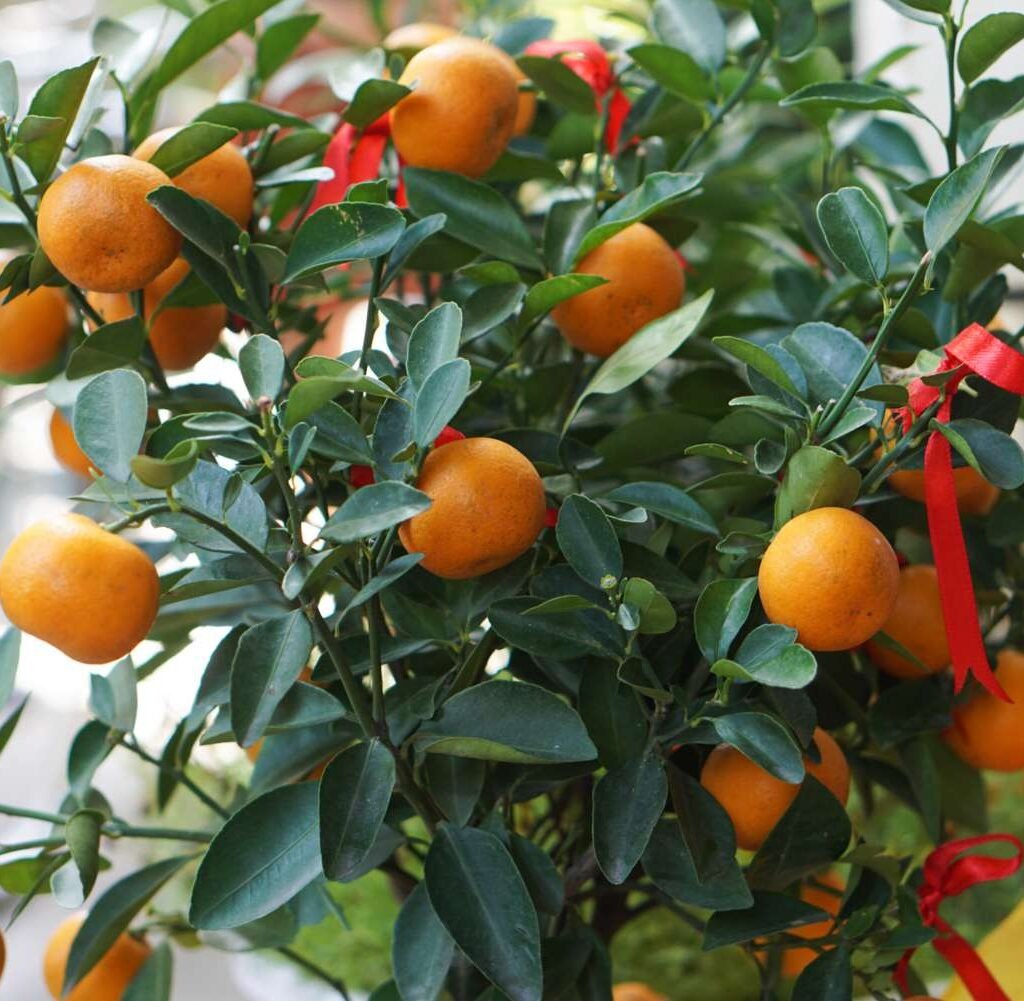
Your orange tree’s health depends heavily on the size and type of container you use. The roots need ample room to grow and spread.
Ideal Pot Size:
- Minimum 18–24 inches deep and 20–24 inches wide.
- Use a container that can hold at least 40–60 liters of soil.
Container Materials:
- Plastic or fiberglass pots: Lightweight, durable, and easy to move.
- Terracotta or clay pots: Breathable and stable but heavier.
- Wooden barrels: Offer good insulation for roots.
Ensure the pot has drainage holes at the bottom. Orange trees dislike soggy roots, so good drainage is essential to prevent rot.
4. Best Soil Mix for Potted Orange Trees

Orange trees need well-draining, slightly acidic, nutrient-rich soil. A high-quality potting mix will ensure good aeration and moisture retention.
Recommended Soil Mix:
- 1 part garden loam or topsoil
- 1 part compost or well-rotted manure
- 1 part sand or perlite for drainage
- Optional: Add a handful of bone meal or citrus fertilizer before planting
Soil pH: Between 5.5 and 7.0 is ideal. Avoid heavy clay soil or pure sand — oranges prefer a balanced mix that drains well but retains nutrients.
5. How to Plant Orange Trees in Containers
Planting your orange tree correctly is crucial for healthy growth. Follow these simple steps:
Step 1: Fill your container halfway with the prepared soil mix.
Step 2: Remove the orange sapling or grafted plant from its nursery pot carefully, keeping the root ball intact.
Step 3: Place the plant in the center of the pot, ensuring the graft union (the swollen part above the roots) stays above the soil line.
Step 4: Fill in the remaining soil, pressing gently to remove air pockets.
Step 5: Water thoroughly to settle the soil and roots.
Pro Tip: Add a layer of organic mulch (dry leaves, straw, or bark chips) on top to help retain soil moisture.
6. Sunlight and Temperature Requirements
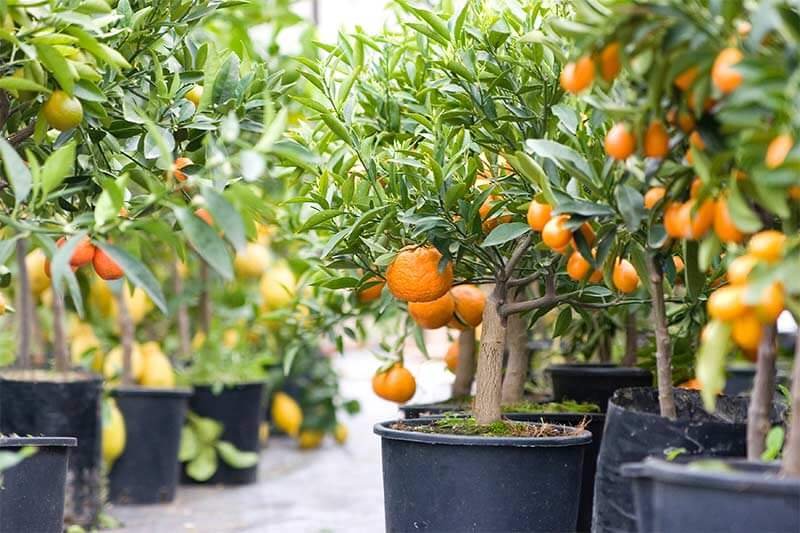
Orange trees love sunlight — it’s the key to sweet, juicy fruits and strong growth.
Sunlight:
- Provide 6–8 hours of direct sunlight daily.
- If growing indoors, place near a south-facing window or use a grow light.
Temperature:
- Ideal range: 20°C–32°C (68°F–90°F).
- Protect from frost; oranges are sensitive to cold.
- Move the pot indoors or cover it during chilly winters.
If your area experiences frequent cold snaps, consider using a portable greenhouse or fleece wraps to protect your plant.
7. Watering Your Orange Tree
Citrus trees enjoy consistent moisture but hate standing water. Finding the right balance is key.
Watering Tips:
- Water deeply whenever the top 2 inches of soil feel dry.
- Reduce watering during winter when the plant’s growth slows.
- Avoid frequent shallow watering; this encourages weak roots.
- Ensure your container drains well after each watering.
To improve humidity, you can mist the leaves occasionally or place a water tray nearby — especially in dry indoor environments.
8. Fertilizing Your Orange Tree
Oranges are heavy feeders and require regular fertilization to stay healthy and produce fruit.
Fertilizer Schedule:
- Use a citrus-specific fertilizer every 4–6 weeks during the growing season (spring through summer).
- Choose a balanced mix like NPK 10-10-10 or one rich in nitrogen and micronutrients (iron, magnesium, and zinc).
- Stop fertilizing in late fall or winter to let the plant rest.
Organic Alternatives: Compost tea, seaweed extract, or banana peel fertilizer provide natural nutrients.
Tip: Yellowing leaves often signal a nutrient deficiency — increase feeding or add trace minerals.
9. Pruning and Shaping Your Orange Tree
Pruning keeps your tree compact, encourages fruiting, and improves airflow.
When to Prune:
- Late winter or early spring before new growth begins.
- Light pruning after fruit harvest.
How to Prune:
- Remove dead, weak, or crossing branches.
- Cut back long, leggy shoots to maintain a rounded shape.
- Remove suckers (small shoots growing from the base) — they steal energy from the main plant.
Pruning also allows sunlight to reach all parts of the tree, promoting uniform fruit ripening.
10. Pollination and Flowering
Most container-grown oranges are self-pollinating, meaning you don’t need another tree for fruit production. However, natural pollination can be improved with insects or hand-pollination.
To Hand-Pollinate:
- Use a small paintbrush or cotton swab.
- Gently transfer pollen from one flower to another.
- Do this during the blooming period (usually spring).
More pollination means more fruit — and that’s what every home gardener wants!
11. Pest and Disease Management
Container-grown orange trees are less prone to pests, but occasional problems can occur.
Common Pests:
- Aphids: Cluster on new shoots; wash off or use neem oil.
- Spider mites: Cause leaf curling; increase humidity and spray organic miticide.
- Scale insects: Appear as brown bumps; wipe off with soapy water.
Common Diseases:
- Root rot: Avoid overwatering.
- Leaf spot or mold: Improve air circulation and avoid wetting leaves.
Regularly inspect leaves and stems, especially the undersides, to catch problems early.
12. Overwintering and Cold Care
If you live in a region with cold winters, your orange tree will need protection during dormancy.
Winter Care Tips:
- Move the pot indoors when temperatures drop below 10°C (50°F).
- Place it near a sunny window or under a grow light.
- Water sparingly — just enough to keep the soil slightly moist.
- Avoid fertilizing until spring.
In mild climates, simply cover the tree with fleece or plastic during frosty nights.
13. Flowering to Fruiting: What to Expect
Orange trees grown from grafted plants may start flowering within 1–2 years in containers. The flowers are small, white, and beautifully fragrant.
After pollination, small green fruits will appear, gradually turning orange over the next few months.
Tips for Better Fruit Production:
- Ensure consistent sunlight and watering.
- Feed regularly with potassium-rich fertilizer during fruiting.
- Avoid moving the pot too often once flowers appear — it may cause fruit drop.
Patience is key; homegrown oranges usually take 8–12 months from flower to harvest.
14. Harvesting Oranges
Oranges don’t continue ripening after harvest, so timing is important.
How to Know When Oranges Are Ready:
- The fruit has turned a rich orange color.
- It feels firm yet slightly soft to touch.
- The peel releases easily when twisted from the branch.
Taste one fruit before harvesting the rest — sweetness increases with time. Harvest carefully to avoid damaging the branches.
15. Repotting and Long-Term Care
Your orange tree will eventually outgrow its pot. Repot every 2–3 years to refresh the soil and encourage healthy growth.
Repotting Steps:
- Choose a pot one size larger than the current one.
- Remove the tree gently, trim damaged roots, and discard old soil.
- Refill with fresh potting mix and replant.
- Water thoroughly and keep in partial shade for a few days.
With proper care, a potted orange tree can live and fruit for 10–20 years!
Final Thoughts
Growing oranges in containers at home is simpler than it seems — all you need is sunshine, patience, and consistent care. From the sweet aroma of blossoms to the joy of harvesting fresh fruit, every step is incredibly rewarding.
Whether you live in a city apartment or a cozy home with limited space, container orange gardening brings a piece of the tropics right to your doorstep. Start small, choose the right variety, and follow these tips — soon, you’ll be enjoying homegrown oranges bursting with flavor and freshness!
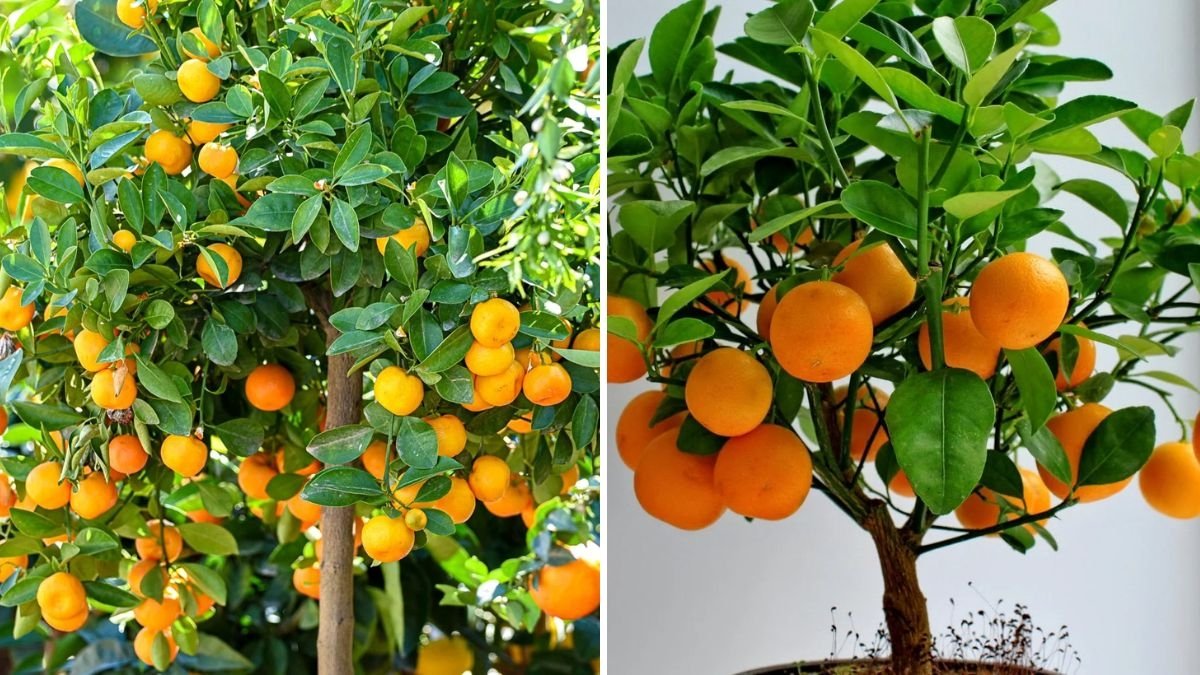
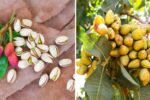
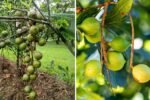



Leave A Comment